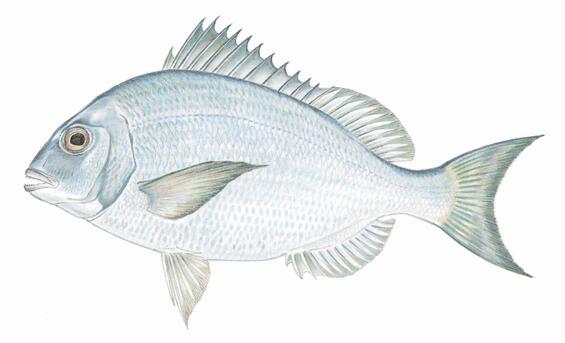Appearance
Scup are a silvery fish with light blue specks and several horizontal stripes. Their bellies are white and they have darker patches on the head. Scup are lean and tall fish, with a small mouth, high set eyes, and one long spiny dorsal fin. They can live up to at least 14 years, weigh up to 5 pounds, and grow up to 18 inches, although most of the catch in Massachusetts consists of fish less than 6 years old, 3 pounds in weight, and 14 inches in length.
Where they live
Scup are a migratory fish, with Massachusetts generally serving as its most northern habitat. From April through October, they may be present in our southern inshore waters, provided sea temperatures exceed 45°F. Larger fish arrive here first from the offshore areas south of New Jersey that they inhabit during colder months. Adult scup school in areas with smooth or rocky bottoms. They are particularly abundant around piers, rocks, offshore ledges, jetties, and mussel beds. Smaller scup are generally in more shallow waters than larger scup. Both juvenile and adult scup move into harbors and along sandy beaches during high tides and return to deeper channels as the tide drops.
Life history
In Southern New England, scup spawn from May to August, peaking in June. By age 2–3 (and roughly 6 inches), most scup are sexually mature. Females release an average of 7,000 eggs per annual spawn, which often takes place over sandy or weedy areas. Fertilized eggs float for about 40 hours before they hatch, and larvae begin feeding on copepods and other plankton within several days. As larvae mature, they settle to the sea floor and develop into juveniles. Each year, as many as 80% of all juvenile scup are eaten by larger predators such as striped bass, bluefish, and black sea bass. Adult scup feed on bottom invertebrates like crabs, annelid worms, clams, mussels, jellyfish, and sand dollars.
Management
Scup are subject to both an interstate and federal fishery management plan. Overall, the management plans allocate 78% of the annual allowed harvest to the commercial fishery, and 22% to the recreational fishery. The commercial fishery is managed by a quota system, minimum fish size, and gear restrictions. An annual commercial quota is divided into three harvest periods, Winter I (Jan–Apr), Summer (May–Sep), and Winter II (Oct–Dec), with the Summer period quota further allocated in percent shares to the states. Gear restrictions include a minimum mesh size for trawls to minimize bycatch of immature fish and an escape panel with degradable hinges on fish pots to prevent them from becoming “ghost fishing” gear. The recreational fishery is managed by regional possession limits, minimum sizes, and season lengths designed to achieve the harvest limit.
Additional Resources
Stock status
The 2017 stock assessment for scup found that the stock is not overfished and is not subject to overfishing. The stock has been rebuilt since it was previously below target levels for spawning stock biomass before the mid-2000s. The next update to the assessment is expected in late 2019.
Angling tips
Scup feed frantically and fight energetically on the line. This fish can be a great target species for children, as scup are relatively small and feeding schools can provide nonstop fishing action. Scup battles can be particularly exciting on a medium-weight spinning or lightweight surf outfit carrying a 10 to 20-pound test line. Some anglers prefer jigging small lures, but most prefer bait fishing.
A typical rig is a bank sinker tied to the end of the line with 1 to 3 snelled hooks (size #1 to #8) tied to loops 6 to 10 inches above the sinker. Sea worms, squid strips, and pieces of clams or fish work well as bait. Squid strips are often favored by anglers because they last well through frantic attacks by a scup school on baited hooks.
Although scup are quick to grab bait, they are hard to hook, and anglers must either set the hook as soon as the tip of the fishing rod shows the slightest dipping or gently lift hooks off the bottom to attract sharp strikes rather than nibbling at the bait. Some anglers will drop their bait into a school of actively feeding scup, count to five, and set the hook, instead of risking having their bait stolen.
Additional Resources
Seafood tips
While scup don’t spoil as quickly as some other fish, icing and cleaning the fish quickly after catching is recommended to fully enjoy the sweet flavor of the meat. The best way to prepare scup is to scale and gut the fish and cook whole. Simple recipes can be the most rewarding for scup, such as frying, grilling, or poaching and serving with melted butter or margarine with a slice of lemon or lime.
